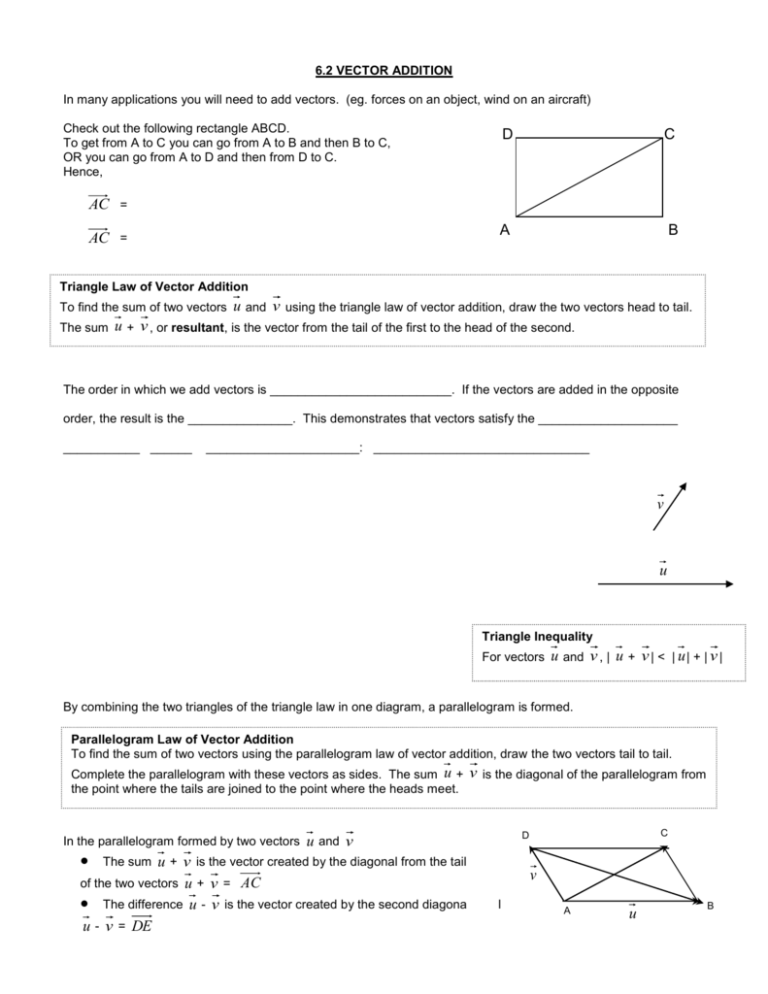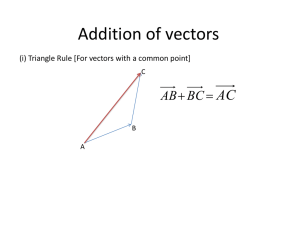6.2 Vector Addition
advertisement

6.2 VECTOR ADDITION In many applications you will need to add vectors. (eg. forces on an object, wind on an aircraft) Check out the following rectangle ABCD. To get from A to C you can go from A to B and then B to C, OR you can go from A to D and then from D to C. Hence, D C A B AC = AC = Triangle Law of Vector Addition To find the sum of two vectors The sum u and v using the triangle law of vector addition, draw the two vectors head to tail. u + v , or resultant, is the vector from the tail of the first to the head of the second. The order in which we add vectors is __________________________. If the vectors are added in the opposite order, the result is the _______________. This demonstrates that vectors satisfy the ____________________ ___________ ______ ______________________: _______________________________ v u For vectors u and v , | u + v | < | u | + | v | Triangle Inequality By combining the two triangles of the triangle law in one diagram, a parallelogram is formed. Parallelogram Law of Vector Addition To find the sum of two vectors using the parallelogram law of vector addition, draw the two vectors tail to tail. Complete the parallelogram with these vectors as sides. The sum u + the point where the tails are joined to the point where the heads meet. In the parallelogram formed by two vectors u and v v is the diagonal of the parallelogram from u + v is the vector created by the diagonal from the tail of the two vectors u + v = AC vector created by the second diagona The difference u - v is the = DE - v u C D The sum v l A u B Ex. 1 Given the three vectors a , b , and c , sketch i) a + b + c ii) a-b+c iii) b - c - a. a b c The Zero Vector Another useful type of vector has magnitude 0. Such vectors are valuable even though their direction is undefined. The zero vector is denoted by 0. B An observation that comes directly from the triangle law of addition is that when two opposite vectors are added, the resultant is the zero vector. This means that the combined effect of a vector and its opposite is the zero vector. In symbols, A AB BA 0 . The angle between two vectors is the angle B A 180 formed when the 0 vectors are placed tail to tail; that is, starting at the same points. Ex. 2 Find the magnitude and direction of the sum of two vectors respectively, and the angle between tem is 30o. u v u and v , if their magnitudes are 5 and 8 units, OA a , OB b , and OD c Express each of the following vectors in terms of a , b , and c . a) BC b) OE c) FA d) CD Ex 3 In the rectangular box shown below, F G D E C B O A Ex. 4 Use the rectangular box above to give a single vector equivalent for each of the following. a) BC CA b) CF EF CB c) CA DO DG AE Ex. 5 A search and rescue aircraft, traveling at a speed of 240 km/h, starts out at a heading of S 20 o W. After traveling for an hour and a half, it turns to a heading of S 70o E and continues for another 2 hours before returning to the base. a) Determine the displacement vector for each leg of the trip. b) Determine the displacement vector for the most direct route.






